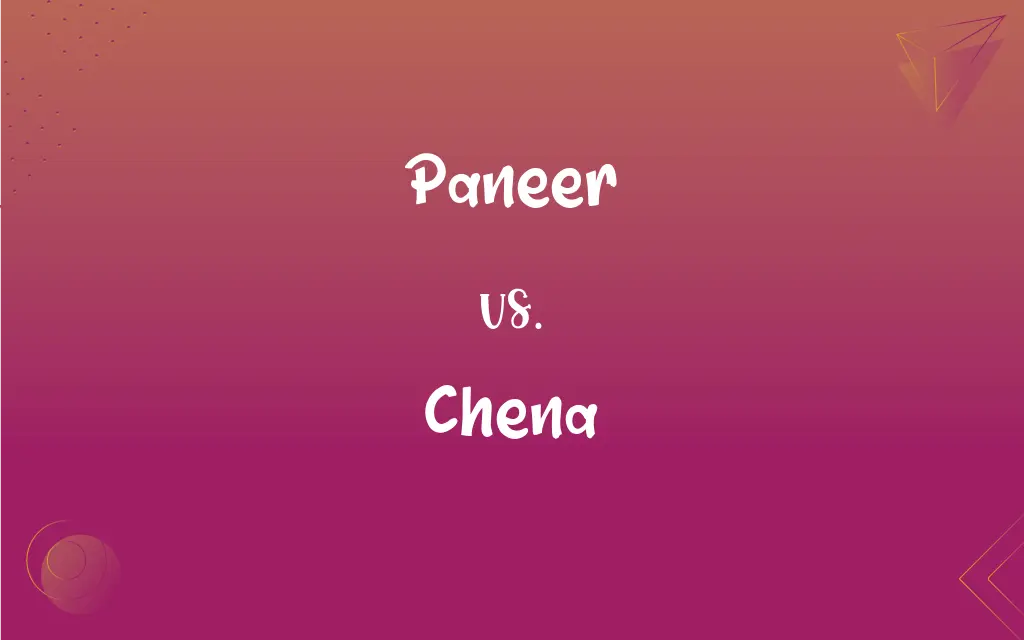Paneer vs. Chena: What's the Difference?
Edited by Aimie Carlson || By Janet White || Published on February 21, 2024
Paneer is a firm, non-melting Indian cheese made by curdling milk and pressing the curds, whereas Chena is a softer, crumbly cheese used in Indian sweets, made by curdling milk without pressing.

Key Differences
Paneer is a type of fresh, non-fermented cheese commonly used in Indian cuisine. It is made by curdling hot milk with an acid like lemon juice or vinegar and then pressing the resulting curds to form a firm block. Chena, on the other hand, is also derived from curdled milk but is not pressed, resulting in a softer, more moist, and crumbly texture.
The preparation process of paneer involves draining the whey from the curds and pressing them under weight, which gives it a firm and dense texture. Paneer can be cut into cubes, fried, or added to various dishes. Chena is prepared by curdling milk and lightly draining the whey, keeping the curds loose and soft, which makes it ideal for making Indian sweets like Rasgulla and Sandesh.
In terms of usage, paneer is a versatile ingredient in savory dishes. It is used in curries, grilled as kebabs, or incorporated into snacks. Chena's usage is predominantly in the realm of sweets and desserts. Its soft texture absorbs flavors well, making it suitable for sweet dishes.
Paneer has a mild, milky flavor that absorbs the flavors of the spices and ingredients it's cooked with. It does not melt, making it suitable for grilling or frying. Chena is known for its slightly tangy flavor and is often sweetened and flavored with cardamom or saffron when used in desserts.
Nutritionally, both paneer and chena are rich in protein and calcium. However, paneer's firmer texture and lower moisture content might make it slightly higher in fat and calories compared to the softer chena, which has a higher moisture content.
ADVERTISEMENT
Comparison Chart
Texture
Firm and dense
Soft and crumbly
Preparation
Curdled, drained, and pressed
Curdled and lightly drained, not pressed
Usage
Savory dishes, grilling, frying
Sweets and desserts
Flavor
Mild, milky, absorbs other flavors
Slightly tang
Paneer and Chena Definitions
Paneer
Rich in protein and calcium.
Paneer is a great source of protein for vegetarians.
ADVERTISEMENT
Chena
Key ingredient in many Indian desserts.
Chena is used to prepare Sandesh, a popular Bengali dessert.
Paneer
A firm, non-melting fresh cheese popular in Indian cuisine.
Paneer tikka is my favorite vegetarian barbecue dish.
Chena
Slightly tangy flavor, often sweetened in desserts.
The chena for this dessert is sweetened with sugar and flavored with cardamom.
Paneer
Made by curdling milk and pressing the curds.
I made paneer at home by adding lemon juice to hot milk and then pressing the curds.
Chena
Made by curdling milk without pressing the curds.
To make chena, I curdle milk and then lightly drain the whey.
Paneer
Has a mild flavor and absorbs spices well.
Paneer cubes absorb the rich flavors of the curry they are cooked in.
Chena
A soft, crumbly cheese used in Indian sweets.
Chena is the main ingredient in the Bengali sweet Rasgulla.
Paneer
Used in a variety of savory Indian dishes.
Paneer butter masala is a classic dish in Indian restaurants.
Chena
Lower in fat compared to paneer due to higher moisture content.
Chena is a lighter alternative to paneer in sweet dishes.
Paneer
A soft unsalted and unripened cheese made from milk that is simmered, curdled using lemon juice, vinegar, yogurt, or a similarly acidic substance, and then drained and pressed in cheesecloth.
Paneer
A soft, non-matured, Indian cheese.
The spinach was mixed with paneer to make a satisfying meal.
FAQs
Can I make paneer at home?
Yes, paneer can easily be made at home with milk and an acid like lemon juice or vinegar.
What is paneer?
Paneer is a type of fresh, non-melting Indian cheese commonly used in savory dishes.
How is paneer made?
Paneer is made by curdling hot milk with an acid like lemon juice and pressing the curds.
Is paneer suitable for frying?
Yes, paneer's firm texture makes it ideal for frying or grilling.
Can paneer be eaten raw?
Yes, paneer can be eaten raw and often is added to salads or served as a snack.
What desserts are made with chena?
Chena is used in a variety of sweets like Rasgulla, Sandesh, and Chena Murki.
Is chena used in savory dishes?
Chena is primarily used in sweets, while paneer is more common in savory dishes.
How is chena different from paneer in preparation?
Chena is made by curdling milk but is not pressed, resulting in a softer texture compared to paneer.
Is chena healthy?
Chena is rich in protein and calcium but should be consumed in moderation, especially when sweetened.
How long can I store homemade paneer?
Homemade paneer can be stored in the refrigerator for up to a week.
What's the best way to store chena?
Chena should be kept refrigerated and used within a few days due to its high moisture content.
Can I freeze paneer?
Yes, paneer can be frozen, but it may change its texture slightly.
What is chena?
Chena is a soft, crumbly cheese used primarily in Indian sweets and desserts.
Does paneer contain lactose?
Paneer contains minimal lactose, making it suitable for some individuals with lactose sensitivity.
Is chena available in grocery stores?
Chena is not commonly found in general grocery stores but can be found in Indian markets or made at home.
Can lactose intolerant people consume chena?
Chena has reduced lactose content due to the curdling process, but it's best to consume it cautiously if lactose intolerant.
Can paneer be used in desserts?
Paneer can be used in some desserts, but its firm texture makes it less common than chena for sweets.
Is chena a good source of protein?
Yes, chena is a good source of protein, similar to other dairy products.
Does paneer need to be cooked before eating?
Paneer does not need to be cooked and can be eaten raw, but it's often cooked in various dishes.
Can I use paneer as a substitute for chena in sweets?
Paneer, being firmer, might not be an ideal substitute for the soft texture of chena in sweets.
About Author
Written by
Janet WhiteJanet White has been an esteemed writer and blogger for Difference Wiki. Holding a Master's degree in Science and Medical Journalism from the prestigious Boston University, she has consistently demonstrated her expertise and passion for her field. When she's not immersed in her work, Janet relishes her time exercising, delving into a good book, and cherishing moments with friends and family.
Edited by
Aimie CarlsonAimie Carlson, holding a master's degree in English literature, is a fervent English language enthusiast. She lends her writing talents to Difference Wiki, a prominent website that specializes in comparisons, offering readers insightful analyses that both captivate and inform.






































































